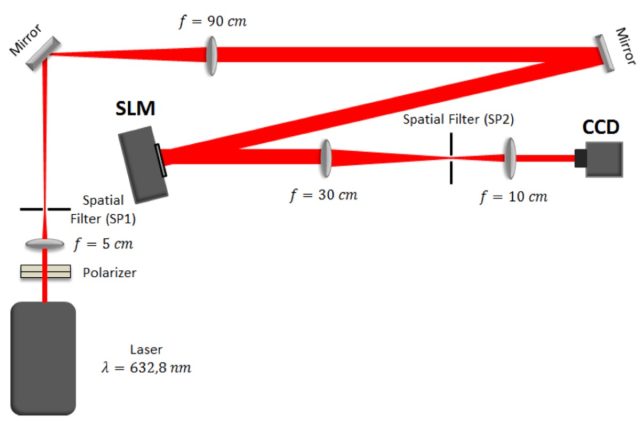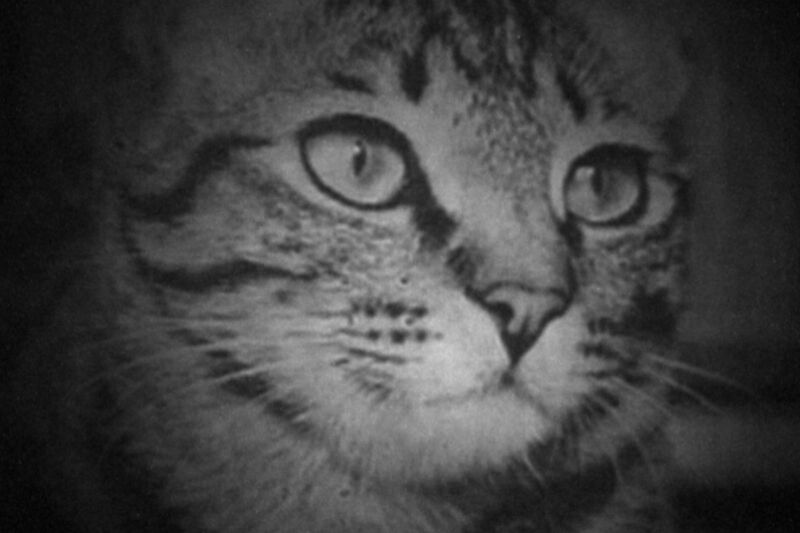Every cat owner knows how their feline companions delight in chasing a tiny pinpoint of light from a simple laser pointer. Now, Brazilian physicists have figured out how to trap and bend laser light into intricate shapes, producing the impressive photorealistic image of a cat pictured above. Among other potential applications, their method—described in a recent paper posted to the physics arXiv—could prove useful for building better optical traps to create clouds of ultra-cold atoms for a variety of quantum experiments.
The ability to produce and precisely control the shape of laser beams with high fidelity is vital for many segments of research and industry, according to co-authors Pedro Silva and Sergio Muniz of the University of Sao Paolo. They group most wavefront engineering approaches into two basic categories.
The first includes such approaches as digital micro mirrors (DMDs) and acoustic optical modulators (AOMs), which are easy to implement and boast a fast response for near real-time feedback control. But they have a limited ability to control the phase of the light field and can't create certain kinds of structured light. They are also prone to speckle, diffraction, or other distortions.

The second group includes holography and various phase-controlled methods, which can create phase-structured light and vector beams. The tradeoff is slower control speeds and a lack of real-time feedback. Silva and Muniz wanted to come up with a phase-controlled approach that implemented some of the desirable features of DMDs and AOMs—notably pixel-to-pixel mapping, simple encoding of light patterns, faster feedback, and more precise control.
Essentially, they improved upon an earlier method proposed in 2007 to get sharper and smoother results. They polarized a diode laser to match the orientation of a liquid crystal serving the purpose of a spatial light modulator. They could organize the crystals with electromagnetic fields to create a series of prisms. Programming the modulator enabled Silva and Muniz to use those prisms to create several arbitrary geometrical shapes—and the fully detailed image of a cat.

"We show experimental results demonstrating that not only simple and flat geometrical shapes can be created using the method described but also complex and feature-rich images with detailed intensity distributions," the authors wrote. And their method might be applied to shape beams from higher-powered pulsed lasers or even ultra-fast lasers.
Useful applications include optical patterning and lithography, as well as optical trapping of ultra cold atoms to create systems such as Bose-Einstein condensates (BECs), which are ideal for simulating quantum effects. For instance, a BEC can "amplify" atoms in the same way that lasers amplify photons, enabling scientists to study the strange, small world of quantum physics as if they were looking at it through a magnifying glass. Physicists have even managed to tie "quantum knots" in BECs and make movies of how the knots decay, or "untie" themselves, fairly soon after forming before turning into a vortex.
But these are fragile quantum systems and must be manipulated with care. An optical trap must therefore be very smooth and precise since any imperfections would knock the atoms out of their quantum state.
“Honestly, I don’t have any good ideas of things you could do with ultra-cold atoms or anything using a picture of a cat, but it’s sort of a proxy to show that you can do very fine and precise features,” Muniz told New Scientist. “We can make these nice-looking images of cats, but we can also use this system to do quantum simulations of electrons and superconductivity [using trapped ultra-cold atoms].”
DOI: arXiv, 2022. 10.48550/arXiv.2204.09724 (About DOIs).
Listing image by P.F. Silva & S.R. Muniz, 2022



3175x175(CURRENT).thumb.jpg.b05acc060982b36f5891ba728e6d953c.jpg)


Recommended Comments
There are no comments to display.
Join the conversation
You can post now and register later. If you have an account, sign in now to post with your account.
Note: Your post will require moderator approval before it will be visible.